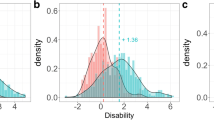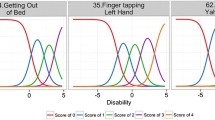Abstract
Purpose
This manuscript aims to precisely describe the natural disease progression of Parkinson’s disease (PD) patients and evaluate approaches to increase the drug effect detection power.
Methods
An item response theory (IRT) longitudinal model was built to describe the natural disease progression of 423 de novo PD patients followed during 48 months while taking into account the heterogeneous nature of the MDS-UPDRS. Clinical trial simulations were then used to compare drug effect detection power from IRT and sum of item scores based analysis under different analysis endpoints and drug effects.
Results
The IRT longitudinal model accurately describes the evolution of patients with and without PD medications while estimating different progression rates for the subscales. When comparing analysis methods, the IRT-based one consistently provided the highest power.
Conclusion
IRT is a powerful tool which enables to capture the heterogeneous nature of the MDS-UPDRS.






Similar content being viewed by others
Abbreviations
- CV:
-
Coefficient of variation
- EOT:
-
End of trial
- IIV:
-
Inter-individual variability
- IRT:
-
Item response theory
- LRT:
-
Likelihood ratio test
- MDS-UPDRS:
-
Movement Disorder Society UPDRS
- MJFF:
-
Michael J. Fox Foundation
- NONMEM:
-
NON-linear mixed effect model
- PD:
-
Parkinson’s disease
- PPMI:
-
Parkinson’s Progression Markers Initiative
- RSE:
-
Relative standard error
- SD:
-
Standard deviation
- SIS:
-
Sum of item scores
- SWEDD:
-
Scans without Evidence of Dopaminergic Deficit
- UPDRS:
-
Unified Parkinson’s Disease Rating Scale
- VPC:
-
Visual predictive check
References
Pringsheim T, Jette N, Frolkis A, Steeves TDL. The prevalence of Parkinson’s disease: a systematic review and meta-analysis. Mov Disord Off J Mov Disord Soc. 2014;29(13):1583–90.
Samii A, Nutt JG, Ransom BR. Parkinson’s disease. Lancet Lond Engl. 2004;363(9423):1783–93.
Hughes AJ, Daniel SE, Blankson S, Lees AJ. A clinicopathologic study of 100 cases of Parkinson’s disease. Arch Neurol. 1993;50(2):140–8.
Braak H, Ghebremedhin E, Rüb U, Bratzke H, Del Tredici K. Stages in the development of Parkinson’s disease-related pathology. Cell Tissue Res. 2004;318(1):121–34.
Frasier M, Kang UJ. Parkinson’s Disease Biomarkers: Resources for Discovery and Validation. Neuropsychopharmacology. 2014;39(1):241–2.
Kalia LV, Lang AE. Parkinson’s disease. Lancet Lond Engl. 2015;386(9996):896–912.
Ramaker C, Marinus J, Stiggelbout AM, Van Hilten BJ. Systematic evaluation of rating scales for impairment and disability in Parkinson’s disease. Mov Disord Off J Mov Disord Soc. 2002;17(5):867–76.
Holford NHG, Chan PLS, Nutt JG, Kieburtz K, Shoulson I, Parkinson Study Group. Disease progression and pharmacodynamics in Parkinson disease - evidence for functional protection with levodopa and other treatments. J Pharmacokinet Pharmacodyn. 2006;33(3):281–311.
Vu TC, Nutt JG, Holford NHG. Progression of motor and nonmotor features of Parkinson’s disease and their response to treatment. Br J Clin Pharmacol. 2012;74(2):267–83.
Perlmutter JS. Assessment of Parkinson Disease Manifestations. Curr Protoc Neurosci Editor Board Jacqueline N Crawley Al. 2009;CHAPTER:Unit10.1.
Movement Disorder Society Task Force on Rating Scales for Parkinson’s Disease. The Unified Parkinson’s Disease Rating Scale (UPDRS): status and recommendations. Mov Disord Off J Mov Disord Soc. 2003;18(7):738–50.
Goetz CG, Tilley BC, Shaftman SR, Stebbins GT, Fahn S, Martinez-Martin P, et al. Movement Disorder Society-sponsored revision of the Unified Parkinson’s Disease Rating Scale (MDS-UPDRS): scale presentation and clinimetric testing results. Mov Disord Off J Mov Disord Soc. 2008;23(15):2129–70.
Louis ED, Tang MX, Cote L, Alfaro B, Mejia H, Marder K. Progression of parkinsonian signs in Parkinson disease. Arch Neurol. 1999;56(3):334–7.
Zetusky WJ, Jankovic J, Pirozzolo FJ. The heterogeneity of Parkinson’s disease: clinical and prognostic implications. Neurology. 1985;35(4):522–6.
Chaudhuri KR, Schapira AHV. Non-motor symptoms of Parkinson’s disease: dopaminergic pathophysiology and treatment. Lancet Neurol. 2009;8(5):464–74.
Poewe W, Hauser RA, Lang A, ADAGIO Investigators. Effects of rasagiline on the progression of nonmotor scores of the MDS-UPDRS. Mov Disord Off J Mov Disord Soc. 2015;30(4):589–92.
Jankovic J, Kapadia AS. Functional decline in Parkinson disease. Arch Neurol. 2001;58(10):1611–5.
Baker FB. The basics of item response theory. 2nd ed. College Park: ERIC Clearinghouse on Assessment and Evaluation; 2001.
Ueckert S, Plan EL, Ito K, Karlsson MO, Corrigan B, Hooker AC. Improved Utilization of ADAS-Cog Assessment Data Through Item Response Theory Based Pharmacometric Modeling. Pharm Res. 2014;31(8):2152–65.
Gottipati G, Karlsson MO, Plan EL. Modeling a Composite Score in Parkinson’s Disease Using Item Response Theory. AAPS J. 2017;
Hoehn MM, Yahr MD. Parkinsonism: onset, progression and mortality. Neurology. 1967;17(5):427–42.
Kjellsson MC, Zingmark P-H, Jonsson EN, Karlsson MO. Comparison of proportional and differential odds models for mixed-effects analysis of categorical data. J Pharmacokinet Pharmacodyn. 2008;35(5):483–501.
Beal S, Sheiner LB, Boeckmann A, Bauer RJ. NONMEM user’s guides. (1989–2009). Icon Development Solutions, Ellicott City, MD USA; 2009.
Vu TC, Nutt JG, Holford NHG. Disease progress and response to treatment as predictors of survival, disability, cognitive impairment and depression in Parkinson’s disease. Br J Clin Pharmacol. 2012;74(2):284–95.
Author information
Authors and Affiliations
Corresponding author
Electronic supplementary material
Supplementary Material A
(DOCX 18 kb)
Supplementary Material B
(DOCX 18 kb)
Supplementary Material C
(DOCX 6044 kb)
Supplementary Material D
(DOCX 316 kb)
Rights and permissions
About this article
Cite this article
Buatois, S., Retout, S., Frey, N. et al. Item Response Theory as an Efficient Tool to Describe a Heterogeneous Clinical Rating Scale in De Novo Idiopathic Parkinson’s Disease Patients. Pharm Res 34, 2109–2118 (2017). https://doi.org/10.1007/s11095-017-2216-1
Received:
Accepted:
Published:
Issue Date:
DOI: https://doi.org/10.1007/s11095-017-2216-1




